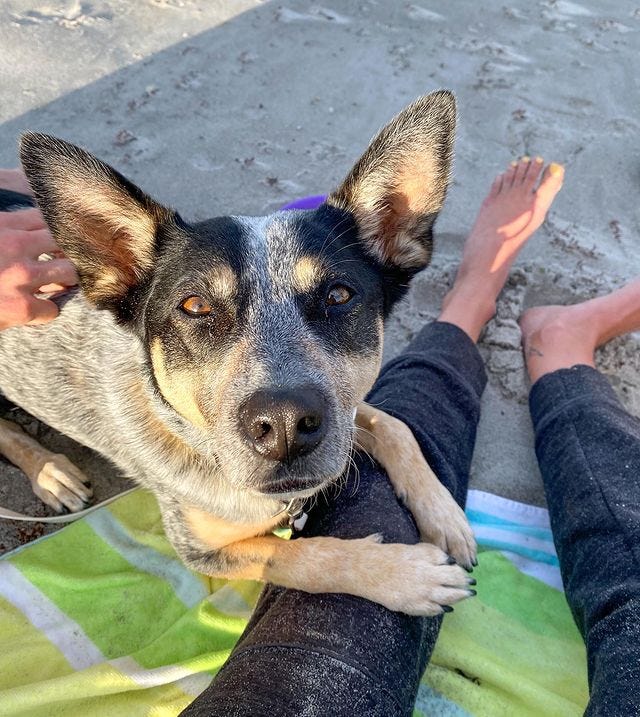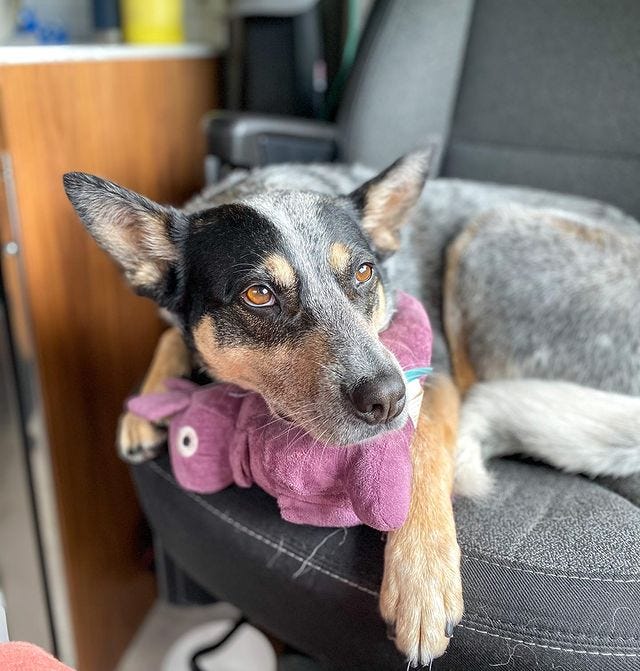It’s been almost a month since we officially hit the road to live in our converted campervan, Hermes. So far we’re loving it, Scout included. I think “the nomad thing” was ultimately a great decision for our little family.
Adjusting to life on the road has come with its challenges, though. Here are some things our cattle dog has struggled with—and how we’re working through them.
Background: How I view my dog’s wellbeing through the layered stress model
The layered stress model has been a big part of my dog ownership journey.
What is the layered stress model?
It’s essentially a framework illustrating how stressors “layer” on top of each other. The more capacity our dogs use on health and lifestyle problems (physical discomfort, lack of fulfillment, and so on), the less they have to tackle other things. When we eliminate as much negative stress as possible at those foundational levels, though? We give them more bandwidth to handle additional challenges!
You can listen to Jay Jack talk about the layered stress model with Pat Stuart and Glenn Cooke from The Canine Paradigm podcast here or watch his YouTube video below.
Similar concepts to the layered stress model
If you’ve ever heard of the pile-on principle or the straw that broke the camel’s back, the layered stress model is a similar idea.
I also think it fits with the spoon theory popular in the chronic illness community. My mom has battled rheumatoid disease for over a decade—I’ve seen firsthand how bandwidth can be limited and “small” things take it up. When we aren’t at our best physically, we’re less able to thrive in other ways. The same is true for our dogs. (This article discusses a specific personal example of Scout’s health affecting her behavior with her seizure med side effects.)
Van life specifics: Things that have been hard on our cattle dog as we travel
Our dog has been sleeping less overall living in the van
After our first few days on the road, we noticed that Scout was acting more tired than she used to at our house. She took fewer naps throughout the day—so sometimes she looked exactly like a toddler trying to “fight sleep” while sitting up and showing interest in the world around them.
I think there are a few reasons the van doesn’t lend itself to as much deep rest as our stationary home did:
Sometimes we’re parked in bright, loud, or otherwise distracting places
We’ve been lucky to spend a lot of time in gorgeous backcountry areas, but some of our overnight spots have been in more crowded areas like downtown parking lots. And even the most peaceful stretches of nature can bombard our dog with new stimuli to investigate.
Scout is a sensitive herding breed who very much wants to know what’s going on nearby… and whose hearing is significantly more developed than ours. It’s no wonder she’s been jolted out of sleep more on the road!
Her car crate isn’t as great of a nap spot as our sedan was
Our heeler used to nap in the backseat of our car just about every time we drove somewhere. While she’s long been crate trained—and we did our best to make her van travel setup as cozy as possible—she hasn’t seemed to be as comfortable sleeping for long stretches while our home on wheels is moving.
How are we making sure she gets enough rest?
The biggest thing here was noticing that Scout wasn’t sleeping as much as she used to in the first place. We’ve since been able to:
Think more critically about where we park overnight to try to maximize her ability to rest
Use our window covers to block the view outside in particularly stimulating areas
Turn on our fan or air conditioning for white noise when necessary
Plan more stationary periods to sit in the van with her since driving time no longer automatically equals nap time for her
Try to balance out quieter rest days with longer walking / hiking adventures
Her sleep schedule is still a bit different than it was when we lived in a traditional home, but our cattle dog no longer seems overtired to the point of emotional or behavioral struggles. I think her quality of rest will continue to improve as we all keep adjusting to life on the road and build more confidence in new places—more on that in the next section!
Quick update 2024: All three of us sleep pretty damn well nowadays.
She’s still nervous in some unfamiliar environments
Scout’s been a “timid” or “shy” dog since I first adopted her. I personally like using the word “sensitive” to describe her temperament.
We’ve come a long way since our early days. Her independence, resilience, and baseline confidence have skyrocketed! But she can still struggle to feel comfortable in completely novel situations—and when you add in the fact that we don’t have a set “home base” to decompress in like we used to, this new lifestyle has definitely taken its toll in some moments.
The biggest ways we can tell Scout is feeling overwhelmed:
Refusing to play either fetch or tug (this is my favorite metric to gauge her comfort)
Turning down food (to be taken with a grain of salt depending on what type of treat we’re offering—she’s more likely to eat than play if she isn’t comfortable)
Alert barking more than usual (some alarm sounds are perfectly normal for her breed and temperament, but sharp increases suggest she’s feeling insecure)
Showing even more submissive or nervous body language than we’re used to (she’s a “soft” dog by default but will really slink around and pin her ears if she’s particularly unsure)
And these things can be a sort of cycle where it’s harder to fulfill her when she’s nervous… meaning it’s harder for her to release stress and relax… again making it even more difficult to fulfill her… on and on and on.
How are we continuing to build her confidence in new places?
Thankfully, though, this is one of those struggles where the challenge itself is also part of the solution. The more exposure Scout gets to different things in the world around her—and the more we take care to support her throughout that exposure so she doesn’t feel left in the deep end on her own—the more comfortable she becomes overall.
We continue to think critically about whether we should bring her into certain environments and we make sure we’re good advocates for her needs. It’s important that she has as many good experiences (and as few bad ones) as possible. Encouraging play (especially tug, a competitive game that helps her feel like a badass and fight through external pressure) continues to be our biggest focus.
We’re seeing her watchdog tendencies come out a bit more
As an Australian cattle dog, it’s natural for Scout to be a bit territorial. We’re completely fine with it so long as she can still take direction from us and settle down quickly!
In the van, though, her focus on “keeping watch” on everything around her can contribute to both of the struggles above: less deep sleep when she can’t stop scanning long enough to relax and reduced confidence if she isn’t sure what to make of something.
Predictably, our heeler struggles most with loud noises outside of the van after it’s dark outside as well as direct approaches (think someone coming to knock on our door vs just walking by parallel).
How are we managing her territoriality?
So far these things have seemed to help Scout settle down in the van:
Leaning deeply into observational learning to help her feel better about strangers approaching and other unfamiliar stimuli (making sure we say hello to people & pets who walk past, showing pleasant interest to sounds, and so on)
Acknowledging her alarm barks (ignoring her completely, in an attempt to “not make a big deal” out of things, tends to exacerbate her worries)
Staying calm ourselves once we’ve let her know we also hear / see whatever is going on
Sending her to her crate (her safe space) or giving her another task (like her snuffle mat or an obedience command) to focus on if needed
We don’t have a reliable routine
This is actually both good and bad. Not having a set routine is fantastic for long-term resilience and adaptability—but it can add some day-to-day stress as we grow into it.
Candidly, this part of van life has actually affected me and Sean considerably more than Scout. We’ve long avoided creating a super strict schedule of expectations to help our cattle dog be more flexible—a bit more on that in this article!—but I didn’t realize just how much we humans depended on certain context cues to get things done throughout the day. In our first week of van life, we missed more doses of Scout’s daily seizure medication than we had in the six months before. Oops.
How are we making sure our dog still has clarity?
Over the last few weeks, Sean and I have developed more reliable habits in the van environment simply as we’ve gotten used to it. For Scout’s part, we’re continuing to make sure we’re communicating clearly and falling back on management (like asking her to hold a place command instead of roaming at liberty, for example) when needed to help her adjust.






